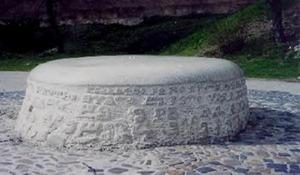
The photograph this week is of the monument on the Nitra Castle grounds commemorating Proglas, described in a wikipedia entry as “the oldest Slovak and Slavic poem, written during 863-867.” Of course, even if you squint at it for quite a while, I would be surprised if you could make anything out, and this is not a problem that stems from the fact that Ludovit Stur had not yet arrived on the scene to codify a literary standard for Slovak.
If we go back to a similar time period in English, the language looks something like this:
Hwæt! We Gardena in geardagum,
þeodcyninga, þrym gefrunon,
hu ða æþelingas ellen fremedon.
Oft Scyld Scefing sceaþena þreatum,
5
monegum mægþum, meodosetla ofteah,
egsode eorlas. Syððan ærest wearð
feasceaft funden, he þæs frofre gebad,
weox under wolcnum, weorðmyndum þah,
oðþæt him æghwylc þara ymbsittendra
10
ofer hronrade hyran scolde,
gomban gyldan. þæt wæs god cyning!
Behind the obvious first impression of the extent to which languages change over time, there are many interesting questions, two of which that immediately come to mind being: (i) Why do we call it “English”? (ii) Why does it look and sound so different from today’s English?
The first question gains in potency as we consider that at the time these lines were composed, “English” (named after the Angles, a Danish tribe that had migrated to parts of Britania around the fifth century A.D., in the wake of the contraction of the Roman Empire), was a collection of vernacular speech styles used in by a largely peasant population numbering at most in the hundreds of thousands and located in southern and midland parts of modern day England. The question is especially pertinent to American, Australian, New Zealand and all the so-called “non-native” speakers of English . . . the vast majority of which trace their family and cultural heritage to places around the globe that have little connection with the tiny island bordering the North Sea.
Assuming we can answer the first question (which I’m hoping that you will take a stab at helping me out with), we can then turn to the second question concerning the mechanisms of change. If language is changing, where do we look to see that change in action? What causes the language to change? Is change inevitable? Casting our eye back on Old English, we can see where English has been. How can we see where it is going in the future? And, finally, what attitude does it make most sense to take with respect to the changes that are happening to language? These attitudes may be important, in that they impact on decisions concerning issues of language planning (regarding which you may wish to preview the material in chapter 11 of Coulmas (Sociolinguistics: The study of speakers’ choices).
In this final little time capsule I have for you, I would like you not only to fathom the linguistic distance between the Old English and its “translation,” but also to react to archaic characteristics in the latter version. How would you translate the prayer into Modern Standard English? How are archaisms distributed across the lexicon, syntax, and phonology of the prayer? What sociolinguistic processes account for the persistence of this older forms in this context?
And now let us pray:
